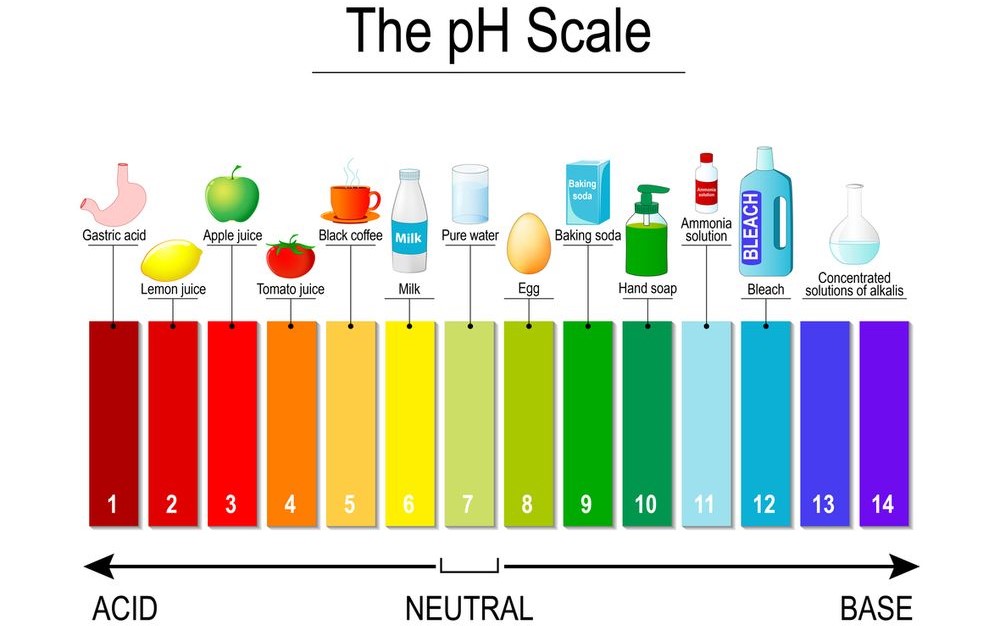Is coffee acidic? Depends on how you take it. If you like to drink your coffee black, then yes, it’s acidic. But add a little milk or cream, and that changes everything – suddenly, coffee becomes more mellow and smooth. Learn more about tackling coffee issues that bother your stomach.

Those of you who have read articles about coffee before have most likely stumbled upon the word acidic used to describe the drink. So naturally, the first question that probably popped into your mind is whether coffee is acidic or not.
Well, that’s what we plan on answering for you today.
Table of Contents
Coffee Acidity – The Basics
Simply put, coffee is acidic but not as much as you might think. Coffee ranks lower on the pH scale than many common fruits and vegetables, including bananas, tomatoes, and carrots – all considered healthy foods.
According to a study, most coffee varieties are acidic, and their pH value ranges from 4.85 to 5.10.
However, several factors play a significant role in the final brew’s pH value, including the type of coffee beans used, grind size, roast, etc.
pH Level Coffee – Acids vs Bases
Acidity is a measure of the concentration of hydrogen ions in a solution. The pH scale runs from 0 to 14, with 7 being neutral.
For instance, pure water has a pH level of 7, making it neutral. Any solution with a pH level below 7 is an acid, while a pH level above 7 indicates a base.

When it comes to foods and drinks, the most common acids are:
- Citric acid (found in citrus fruits).
- Ascorbic acid (vitamin C).
- Lactic acid (found in sour milk and cheese).
The most common bases that you probably use daily are:
- Sodium bicarbonate (baking soda)
- Potassium hydroxide (lye)
- Ammonia
Acidity Effects
A balanced lifestyle is key to a healthy body, and this includes keeping your pH levels close to their natural value – 7.35 to 7.45. Otherwise, you will start experiencing health issues.
A coffee’s naturally acidic pH is caused by nine primary acids:
- Chlorogenic
- Quinic
- Citric
- Acetic
- Lactic
- Malic
- Phosphoric
- Linoleic
- Palmitic
Besides affecting your brew’s pH levels, these acids influence the coffee flavor:
- Chlorogenic acid – a more complex compound broken down during the roasting process into quinic and caffeic acid. These are almost exclusively responsible for your coffee’s bitterness, sourness, and overall astringency.
- Citric acid – most notably found in lemons, oranges, and other citruses, which can give your coffee a mild citrusy feel.
- Malic acid – commonly found in green apples, which gives brewed coffee a juicy and sharp feel.
- Acetic acid (vinegar) – it too can be found in coffee, which gives it that pungent feel that a lot of people hate.
However, the biggest issue with coffee’s natural acidity is the adverse effects on people suffering from gastroesophageal reflux disease (GERD).
Tea Acidity vs Coffee Acidity
Tea and coffee are rivals, so it’s only natural to wonder how their acidity levels compare.
Unfortunately, it’s hard to say which one is more acidic because it depends on the specific tea or coffee variety and how it’s prepared.

For example, the pH values tend to vary in tea varieties:
- Rosehip and blackberry tea – pH 2-3
- Lemon tea – pH 3
- Black tea – pH 4.9-5.5
- Chamomile, mint, and fennel tea – pH 6-7
- Green tea – pH 7-10
A very sour taste is a telltale sign that a particular tea variety may be acidic. However, further studies revealed that fruit teas, which are inherently sweeter than herbal teas, are significantly more acidic.
Coffee Acidity – pH vs Flavor
Many people get confused when hearing about a coffee’s acidity because they think it refers to the beverage’s pH. In fact, it’s just a word used to describe the coffee’s flavor, aroma, and mouthfeel.
You see, all coffee beans contain certain acids that contribute to the final taste of your cup. For example, citric acid is known for its tangy and sour notes, while malic acid tastes like green apples.
The problem is that these acids can sometimes be too harsh for our taste buds, so we tend to think of coffee as acidic.
However, it’s important to note that the actual pH level of coffee has little to do with its flavor profile.
Is Decaf Coffee Acidic?
Yes, decaf coffee may be slightly acidic.
Since the caffeine inside the coffee beans is tied to many acidic compounds, it’s natural for many people to assume that decaf coffee is less acidic.
According to a scientific study, decaf coffee is usually less acidic than the caffeinated version because the decaffeination process eliminates many phenolic acids; these contribute to the brew’s bitterness and sourness. However, some acids are overlooked.
Nevertheless, many consumers have noticed that decaf coffee leads to fewer cases of heartburn and acid reflux.
How to Reduce Coffee Acidity
Thankfully enough, a coffee’s acidity is something you can adjust to your liking. Here are a few tips on how to lower it:

- Use a coffee tamer – it reduces coffee acidity without affecting flavor and contains calcium, potassium, and magnesium.
- Switch to Arabica beans – these beans have a lower acidity level than Robusta beans.
- Use a low-acid coffee blend – several brands offer coffee beans specifically blended to reduce coffee acidity.
- Examine a coffee’s growth environment – coffees grown at higher altitudes tend to be more acidic than those at lower altitudes.
- Use dark roast – the darker the roast, the less acidic.
- Switch a finer grind – the bigger the ground, the smaller the surface area exposed relative to volume, meaning that more acid is extracted in the brewing process.
- Use more water – the more water you use, the less concentrated the coffee will be, making it less acidic.
- Add milk or cream – this will help neutralize some of the coffee’s acids, especially almond milk.
- Drink cold brew coffee – since cold brew is made with grounds steeped in room-temperature water for an extended period, it tends to be less acidic than regular coffee (check out our cold brew coffee recipes).
- Shorter brewing times – the longer you brew your coffee, the more acidity will be extracted from the grounds during the brewing process.
- Add a pinch of table salt or baking soda – this will help neutralize the coffee’s acids.
Acidic Coffee (FAQ)
Discover more helpful information about acidic coffee:
Is coffee an acid or base (alkaline)?
Coffee is slightly acidic, with a pH level that ranges from 4.5 to 5.5.
What makes coffee so acidic?
Coffee is so acidic because it’s filled with organic acids, such as citric, malic, acetic, and chlorogenic acids.
Is coffee bad for acid reflux?
Unfortunately, just like any other food or beverage with an acidic profile, coffee is bad for acid reflux and can worsen the symptoms.
Is espresso less acidic than coffee?
Yes. Espresso is generally less acidic than regular coffee, with a pH level of 6 to 6.5. But it’s because espresso is usually made with milk or cream, which helps neutralize acid.
Is cold brew coffee less acidic?
Cold brew coffee is less acidic than regular coffee, with a pH level that ranges from 5.5 to 6.5.
It’s because coffee for cold brew is made with grounds steeped in room-temperature water for an extended period, which reduces the amount of acidity extracted from the beans.

Can I make my coffee less acidic?
Yes, you can make your coffee less acidic using a coffee tamer, dark roast beans, adding milk or cream, drinking cold brew coffee, or switching to a low-acid coffee blend.
Is dark roast coffee less acidic than light roast?
Yes, dark roast coffee is less acidic than light roast coffee because the extended roasting process breaks down more of your coffee’s acids.
How acidic is coffee with cream?
It mostly depends on the cream’s pH level and amount you add. Most creamers typically have a pH of around 6.7 to 6.8 (higher than coffee), thus reducing acidity.
Which coffee is less acidic?
Arabica beans typically have a lower acidity level than Robusta beans. Dark roast Arabica with coarse grounds is one of the best low-acid coffees.
What is low acid coffee?
Low-acid coffee is a generic term used on coffee varieties purposely grown, roasted, and ground to have the least possible effect on your stomach’s acidity levels.
Is tea less acidic than coffee?
It depends on the tea. For example, rosehip, blackberry, and lemon tea are significantly more acidic than regular coffee, while black and green tea are more alkaline.
Closing Thoughts on Acidic Coffee
So, is coffee acidic? The answer is yes, and we hope that our article managed to shed some light on the subject.
While coffee’s acidity may not be ideal for everyone, it doesn’t mean that you have to give it up altogether. There are plenty of ways to reduce its acidity, so feel free to experiment until you find one that works best for you.
If you have any other questions about coffee’s acidity, feel free to leave them in the comments section below, and we’ll do our best to answer them.
Leave a Reply